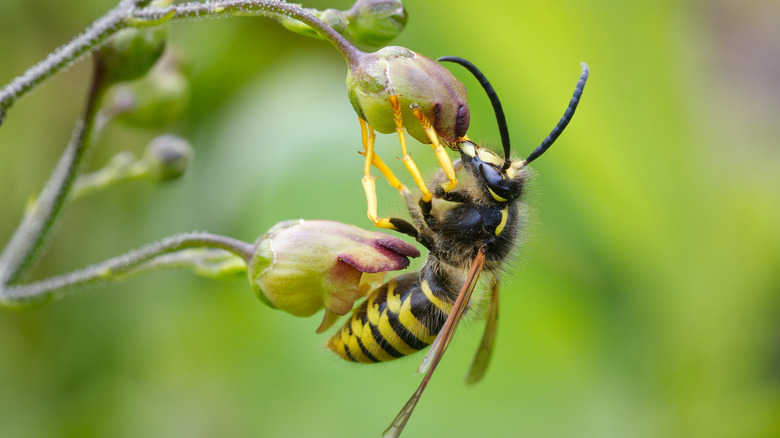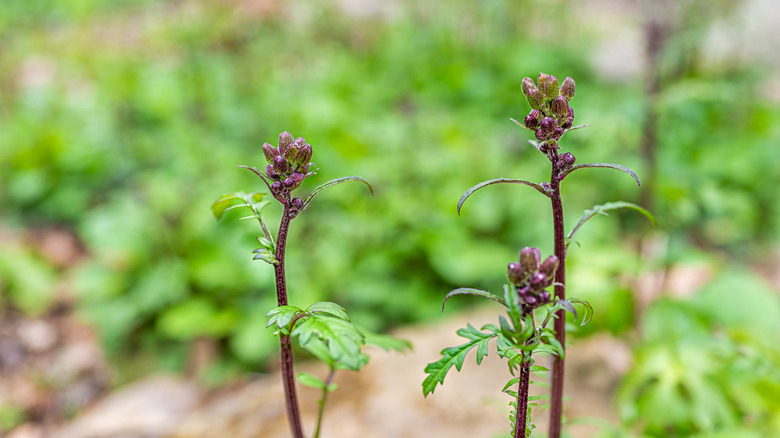Are Figwort Plants Really Attracting Wasps To Your Garden?
As wonderful as a garden full of pollinators like butterflies and hummingbirds may be, wasps are often less welcome. Considering how aggressive some wasps like yellowjackets can be, this is understandable ... especially if you happen to be allergic. Figwort plants (Scrophularia spp.) have long had a reputation for attracting these stinging insects — so much so that they used to be called "wasp flowers."
Knowing this, it might be tempting to remove all your figwort flowers in the hopes of keeping your yard wasp-free. But before you start pulling up plants, it may be worth learning more about the relationship between wasps and figwort, and considering if a complete removal of these perennials is really the best course of action. You can
While it's true that figworts can sometimes attract wasps, this is largely because they have a lot of nectar, making them beloved by wildlife. In addition to wasps, these plants also tend to be visited by bees, hummingbirds, and butterflies. Removing your figwort might not just leave your yard with fewer wasps, but also with fewer pollinators, which isn't ideal for your garden overall.
Growing and caring for figwort in the garden
If you've opted to leave your figworts alone, or maybe even plant more despite their tendency to attract pollinators that include wasps and bees, then you're in for a treat. Figworts are generally low-maintenance plants that thrive in anything from full sun to part shade. They could be great flowering plants to add to a rain garden thanks to their preference for moist soil.
While their hardiness may vary slightly depending on the specific species, late figwort (Scrophularia marilandica) is hardy in zones 4 through 8 and early figwort (Scrophularia lanceolata) is hardy in zone 3 through 7. Because some figworts can often grow as tall as 10 feet, you may want to add these herbaceous perennials towards the back of your garden.
With multiple species native to North America, figworts are a great way to increase the number of native plants in your yard. Remember, you can always grow your figwort and other pollinator plants in a section of your yard far away from where your family tends to eat and socialize, decreasing the chances of wasps ruining your picnics.
Repelling wasps without getting rid of your pollinator plants
If you're looking for ways to have fewer wasps in your yard without resorting to removing all your pollinator plants, there are some things you can do. First, don't assume that all wasps you see are necessarily aggressive. Most wasp stings are from paper wasps, yellowjackets, and hornets. Many other wasps rarely sting people, and some wasps like parasitoid wasps don't sting at all, but instead help out in the garden by destroying aphids and other garden pests.
If you are unlucky enough to have aggressive wasps in your yard, avoid leaving sugary foods and drinks out, and make sure your garbage can is tightly closed. Fruit trees are also notorious for attracting wasps. If there is an aggressive wasp nest very close to your home, consider using a wasp spray or hiring a professional to spray the nest — especially if you're allergic to wasps. If you decide to get rid of the wasps yourself, be sure to wear protective clothing and spray the nest at night.
If your heart is set on removing the figwort plants, however, simply dig up them up at the roots, preferably before the seeds and flowers begin to develop. Glyphosate-based herbicides can be used as well, but make sure they're applied at the roots and nowhere near your edible plants.


